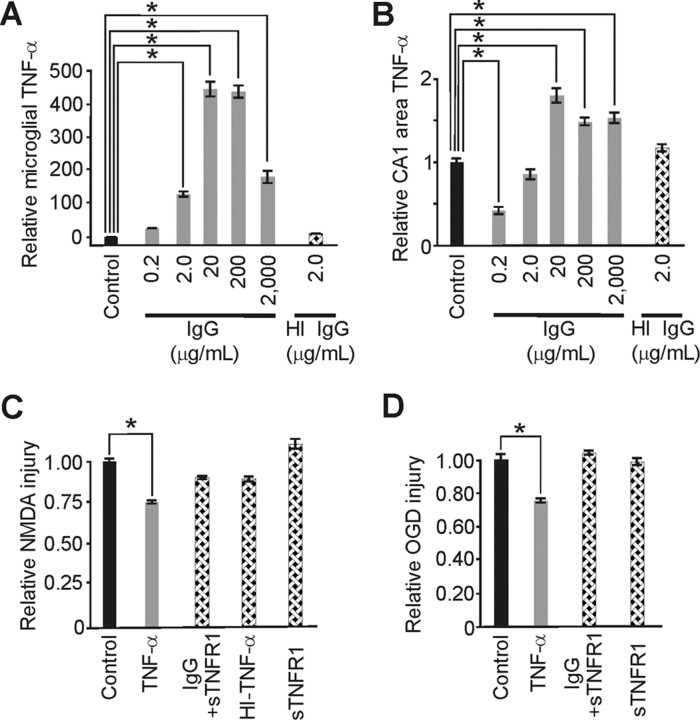Figure 4.
IgG-based neuroprotection from excitotoxic injury involved microglial TNF-α. A, IgG elevated TNF-α at 0.2 μg/ml and triggered significant (p < 0.001; α = 1.00) U-shaped increases in TNF-α from primary microglia over the remaining dose range [but heat inactivation (HI) of IgG (2.0 μg/ml) had no effect] [with respective relative levels of 29 ± 0.2, 123 ± 14, 445 ± 48, 436 ± 41, 175 ± 39 and 11 ± 0.4 compared with (control 1.00 ± 0.2; n = 6/group]. B, Slice culture TNF-α responses to increasing IgG, although similar, also showed a significant (p < 0.002; α = 1.00) drop from control at 0.2 μg/ml IgG (perhaps because of a disproportionately increased TNF receptor expression at this dose) and significant (p < 0.001; α = 1.00) increases at 20, 200, and 2000 μg/ml. HI of neuroprotective IgG (2.0 μg/ml) had no effect on slice culture TNF-α [with respective relative levels of 0.41 ± 0.10, 0.83 ± 0.12, 1.77 ± 0.16, 1.45 ± 0.09, 1.53 ± 0.11, 1.30 ± 0.06 (n = 5/group) vs control (1.00 ± 0.10; n = 20)]. C, Notably, TNF-α pretreatment alone for 3 d mimicked IgG-based significant (p < 0.001; α = 1.00) neuroprotection from NMDA. Removal of TNF-α signaling via coapplication of soluble TNF receptor 1 (sTNFR1) abrogated neuroprotection from an otherwise neuroprotective IgG dose (20 μg/ml) as did HI of TNF-α (100 pg/ml), as did treatment with sTNFR1 alone [with respective relative injury levels of 0.75 ± 0.02 (n = 12), 0.90 ± 0.03 (n = 6), 0.89 ± 0.03 (n = 6), and 1.14 ± 0.06 (n = 12) compared with control (1.00 ± 0.04; n = 21)]. D, Similar significant (p < 0.001; α = 0.99) protective effects from TNF-α treatment were seen with excitotoxic injury from OGD and abrogation of protection at 2.0 μg/ml IgG with inclusion of sTNFR1. [Respective relative injury levels were 0.74 ± 0.03 (n = 18), 1.05 ± 0.06 (n = 14) and 0.98 ± 0.04 (n = 15) compared with control (1.00 ± 0.05; n = 24)]. Data represent mean ± SEM and significance (*p < 0.05).

